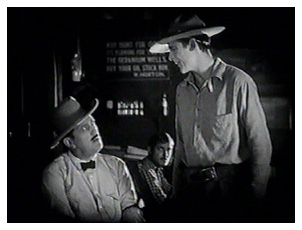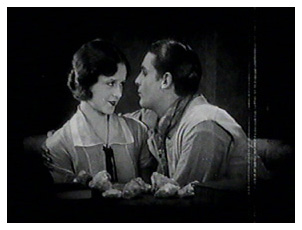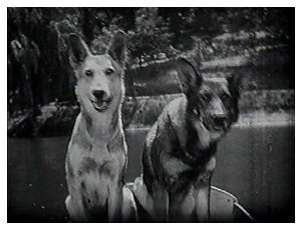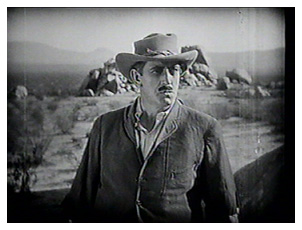

Warner Brothers
Rin Tin Tin (Lobo), June Marlowe (May Barstowe), Charles Farrell
(Dave Weston), Heinie Conklin (Alkali Bill), William Walling (Sam
Barstowe), Pat Hartigan (William "Borax" Horton)
Lobo (a half-breed wolf), his mate, wolf pups and pack are
driven from the forest because of a fire. They arrive at the desert
looking for food and begin killing cattle. Dave Weston is a prospector
and discovers borax out in the desert. He has a girlfriend, May,
but her father disapproves of Dave. The local chemist, whom Dave
must get to test his borax, is an unscrupulous claim jumper named
Horton. When Lobo takes a fall from a cliff while being chased
by May's father and a group of men hunting the wolves, he  falls from a cliff onto a cactus. He is only
temporarily hurt, but a large thorn is in his foot. Realizing
the pack will kill him at the first sign of weakness, he goes
off into the desert to die. Dave finds him, removes the thorn,
and takes the half-breed wolf in. When Dave goes into the desert
during a sandstorm to stake his claim, Horton follows him. The
two men fight, and Dave is left for dead. In the meantime, Horton
goes into town and files the claim in his name. Lobo drags Dave
into a cave away from the sandstorm. Dave writes a message to
May on his canteen and gives it to Lobo to take to her. Unfortunately,
when Lobo sees Horton, he drops the canteen and goes for the man
who tried to kill his master. Horton successfully wards off the
animal, and Lobo must flee the town. May picks up the canteen
after the incident, and not realizing there is a note on it, gives
it to Horton thinking it is his. It is now up to Lobo to figure
out a way to get help to his master before he dies in the desert.
falls from a cliff onto a cactus. He is only
temporarily hurt, but a large thorn is in his foot. Realizing
the pack will kill him at the first sign of weakness, he goes
off into the desert to die. Dave finds him, removes the thorn,
and takes the half-breed wolf in. When Dave goes into the desert
during a sandstorm to stake his claim, Horton follows him. The
two men fight, and Dave is left for dead. In the meantime, Horton
goes into town and files the claim in his name. Lobo drags Dave
into a cave away from the sandstorm. Dave writes a message to
May on his canteen and gives it to Lobo to take to her. Unfortunately,
when Lobo sees Horton, he drops the canteen and goes for the man
who tried to kill his master. Horton successfully wards off the
animal, and Lobo must flee the town. May picks up the canteen
after the incident, and not realizing there is a note on it, gives
it to Horton thinking it is his. It is now up to Lobo to figure
out a way to get help to his master before he dies in the desert.
Another Rin Tin Tin film, "The Night Cry" (1926), is included on our list of "Features of the Month" and would be recommended as a better film than "Clash of the Wolves." Not that "Clash of the Wolves" isn't an above-average picture with lots to recommend it, but, it does have several areas that could stand improvement.
A good drama doesn't necessarily have to include humor, but the stories that fall short of exceptional are usually improved with some well-placed, moderately-balanced humor inserted at just the right moments. "Clash of the Wolves" is fortunate to have former Mack Sennett comedian Heinie Conklin in the cast, and he certainly adds to the enjoyment of the film. When he and May arrive at Dave's remote cabin, Bill (Conklin) pulls his gun out to fire a shot to let Dave know they have arrived. Still sitting on the wagon, Bill is busy talking to May, and when he turns his head, he realizes he has the barrel of the gun pointed at his face rather than the other way around. Once this is corrected, he fires the gun without looking where he's shooting, and the bullet flies throught the window of the cabin barely missing Dave. Bits of business such as this recall the old Keystone days and provide a respite from the heavy drama that potentially could get bogged down.
On the other hand, Motion Picture magazine said,
" . . . there is not enough of this marvelous dog and too
much cheap comedy." Although the film would be less enjoyable
if not for Conklin's humor, the reviewer maybe has a point. For
example, when Bill puts a fake beard on Lobo (Rin Tin Tin) so
no one in town will recognize him (or realize he's a wolf), it
appears more "silly" than "funny" (much less
believable). The very idea that no one will recognize the animal
because he has a short, scruffy beard on his  lower
jaw, held in place with an elastic cord, is preposterous. What's
even more preposterous is that Horton does not recognize Lobo
until the animal tugs at the beard and gets it off his face. Suddenly,
as if someone had removed a mask from his face, Horton registers
a look of surprise as he realizes this is Lobo and pulls his gun.
lower
jaw, held in place with an elastic cord, is preposterous. What's
even more preposterous is that Horton does not recognize Lobo
until the animal tugs at the beard and gets it off his face. Suddenly,
as if someone had removed a mask from his face, Horton registers
a look of surprise as he realizes this is Lobo and pulls his gun.
There is also some weakness in the development of the characters. Farrell, who was a young 20-years old when the film was made, fails to impress as the male lead. This is a fault of the storyline and not Farrell's acting abilities. He is easily beaten by Horton at least three times during the film, and does nothing to bring about the resolution of the story's conflict. It's all Rinty. This lack of strength and/or ability may be an accurate depiction of what real life can be like, but it's unacceptable for the hero (human, hero, that is) of a film. To Farrell's credit, one need only look a year later in his career at "Old Ironsides" (1926). Farrell is still depicted as a young man, not equal to the strength of the men with whom he associates, but, nevertheless, scrappy and resourceful -- a young lad who overcomes and earns the viewer's respect and admiration. The writers would have done well to make Farrell's character stronger and have him work with his canine lead to defeat the evil in the film.
June Marlowe (best known as Miss Crabtree, the school teacher in some of the early sound "Our Gang" shorts) is a pleasant addition to the film. Again, the script is to blame for her lack of anything to do. Marlowe had a subdued style of acting and didn't subscribe to the Clara Bow school of effervescent theatrics, but she has a naturalness about her and a wholesome seductivness that could have been put to better use. In one scene, we see May (Marlowe) and Dave (Farrell) sitting at a table in her house acting as if they are studying something and having a very platonic conversation. This is all for the benefit of her father who is in the next room. However, when he leaves the house and puts Bill in charge of watching them, they steal kisses with Lobo as their lookout. This gives the viewer a brief glimpse of the coquettish sexuality she could bring to a role, although her few minutes of screen time with John Barrymore in "Don Juan" (1926) are much more representative of her appeal than all of her screen time in "Clash of the Wolves." In "Don Juan," she is seductive, beautiful, sexy and filled with a certain amount of "fire" that just wasn't tapped in "Clash of the Wolves." It's unfortunate she did not enter movies 10 years earlier. She undoubtably would have been a major player on the silent screen rather than being best remembered for a couple of "Our Gang" comedies. As a side note, Warner Brothers obviously felt she was well-suited for these films. She made a total of five with the canine star.

To the script's credit, "Clash of the Wolves" does contain excitement and adventure. Viewers in the 1920's expected this combination in a Rin Tin Tin film, and they got a full dose each time. Several of Rinty's silent features are available for viewing today including "Where the North Begins" (1923), "Hills of Kentucky" (1927), "Tracked by the Police" (1927), "The Night Cry" (1926) and "The Lighthouse by the Sea" (1924). All are filled with excitement and enough thrills to keep the viewer enthralled for 60-75 minutes. Warner Brothers deserves credit, too, for decent production values on the Rin Tin Tin films. "Clash of the Wolves," for example, has a real western look, and the desert scenes are stark, dry, and hot. Even the sandstorm scene is a realistic portrayal.
From the very beginning, we see that this movie is not one of the typical cheap "B " westerns that were churned out regularly for the Saturday afternoon audiences. The film opens with a forest fire. The first scene we see is a distant view of this fire with a river running between a burning forest on either side. There's no doubt this is a miniature, but it, too, it well done. Then the scenes of Rinty scurrying between the burning trees to rescue his pups and take them to safety are believable and exciting. Of course, there's a good reason Warner Brothers maintained a certain level of quality on the Rin Tin Tin features. Supposedly, these are the films that kept the beleaguered studio out of bankruptcy throughout most of the silent era.
Realizing Rin Tin Tin was the real drawing card, he is given all of the action, the heroics and the credit for saving the day. There wasn't much that he couldn't do, including making difficult decisions that some humans would have a tough time making. Jeanine Basinger devoted a chapter to Rinty in her book "Silent Stars" (Alfred A. Knopf, 1999), "The astonishing thing about watching Rin Tin Tin is that you begin to agree that this dog could act." And she is right about that. However, it would have helped the script considerably if the human leads could have at least assisted in the solving of the problems, but, instead, they (Dave, in particular) are portrayed as almost inept.
The producers obviously knew what they were doing, though. At the height of his career, Rin Tin Tin was receiving 10,000 letters a week and earning $6,000 a month for him and his master, Lee Duncan. Everyone knows the story of how Duncan found Rin Tin Tin in France during World War I and brought him home. His name was taken from a good luck doll the French peasants sold the soldiers.
"Clash of the Wolves" has been available on video
for years in an only fair print with a "pieced-together"
orchestral score. The original source material for that video
release is unknown. However, a nitrate print from South Africa
made its way to the Library of Congress through the American Film
Institute and was restored in 2003. This print is  now
available on the "More Treasures from the American Film Archives"
DVD set and is excellent quality. There are scratch lines occasionally,
but they barely detract from the viewing pleasure of this nice,
crisp print. One of the attractions of this film, too, is that,
true to the style of most Warner Brothers pictures during this
period, the intertitles include wonderful artwork that make the
film all the more entertaining to see. All the original titles
are there, and, along with the great visual quality and a superb
piano score by Martin Marks, make this a welcome addition -- in
spite of the above-mentioned shortcomings -- to any silent film
buff's collection.
now
available on the "More Treasures from the American Film Archives"
DVD set and is excellent quality. There are scratch lines occasionally,
but they barely detract from the viewing pleasure of this nice,
crisp print. One of the attractions of this film, too, is that,
true to the style of most Warner Brothers pictures during this
period, the intertitles include wonderful artwork that make the
film all the more entertaining to see. All the original titles
are there, and, along with the great visual quality and a superb
piano score by Martin Marks, make this a welcome addition -- in
spite of the above-mentioned shortcomings -- to any silent film
buff's collection.
End Note: For anyone wishing to read further about Rin Tin Tin in Basinger's book, some inaccuracies regarding "Clash of the Wolves" should be noted.
Basinger says her "favorite example of Rinty's ingenuity" is a scene when, in order to avoid being recognized, he "goes into a general store, locates a beard, dons it, and emerges -- well disguised as a kind of goat or very weird-looking other dog." This does not occur in "Clash of the Wolves." Heinie Conklin's character, Bill, is afraid Lobo (Rinty) will be recognized for the wolf that he is when his owner, Dave, takes him into town. So, it is Bill who places the beard around Rinty's lower jaw to keep him from being recognized (obviously, reality must be suspended somewhat to accept this silly premise).
Basinger adds, "In this same movie, he also puts on little boots partly because he has a bum foot." The part about the bum foot is correct, but it's his owner, Dave, who puts the boots on Rinty (They appear to be made specially to fit Rinty's feet, so we must assume Dave created them, too, although that is not shown in the film). Rinty does, indeed, get them off his feet later, as Basinger describes, but it would be rather difficult for a dog, even Rinty, to put on a pair of small boots and lace them up.
Basinger continues to mislead the reader about the contents of this film by describing a scene that certainly doesn't appear in either of the two prints this reviewer has seen. She says, ". . . knowing his master is dying of thirst out in the canyon, he galumphs into town and fills the canteen himself using his teeth to open it and turn a spigot on." What actually happens is that Dave is injured in the desert. He writes a note on his canteen and tells Rinty to take it to May (Marlowe). The dog never goes near a spigot. In fact, he loses the canteen in town, and it ends up in the hands of Dave's nemesis, Horton. At one point we do see Rinty dropping an open canteen into a waterhole and holding it down with his paw so the water will go into the opening; however, he certainly doesn't take the top off the canteen or put it back on.
Copyright © 2005, by Tim Lussier. All rights reserved.